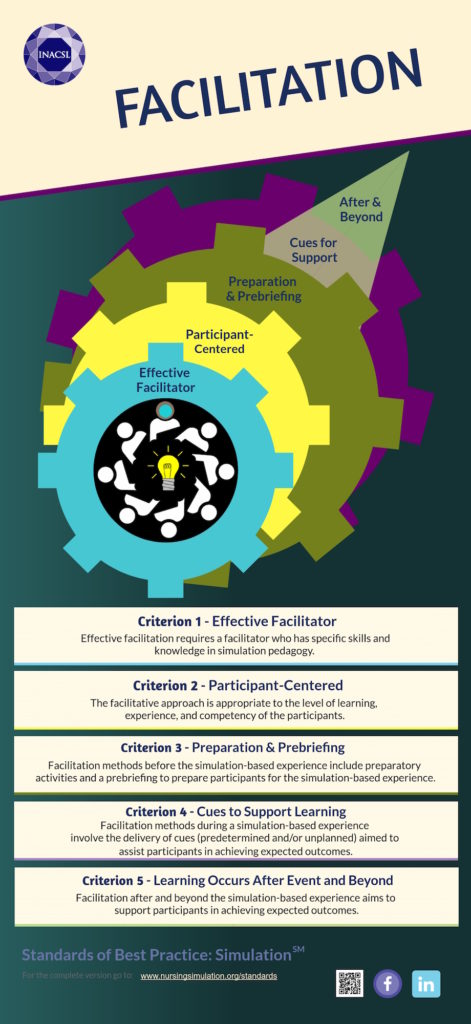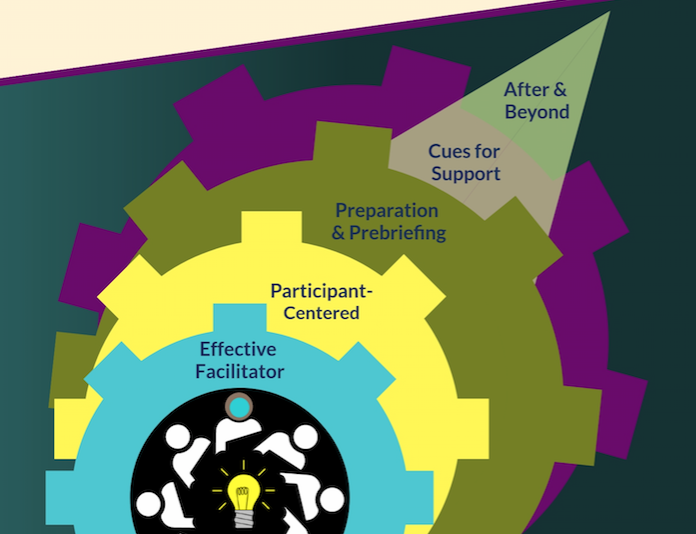INACSL Standards of Best Practice Infographic: Facilitation
Check out the third of seven awesome new infographics produced by INACSL to demonstrate the key points of their recently updated Standards of Best Practice: Simulation. The second one focused on Outcomes & Objectives, reminding us that all simulation-based experiences begin with the development of measurable objectives designed to achieve expected outcomes. This third one focuses on Facilitation: suggesting that while facilitation methods are varied, we must use a specific method depending on the learning needs of the participants and the expected outcomes. A facilitator assumes responsibility and oversight for managing the entire simulation-based experience.
Check out the links below to get high-resolution versions that you can print out for your medical simulation programs!

Sponsored Content:
About Facilitation
Facilitation of a simulation-based experience requires a facilitator who has the education, skill, and ability to guide, support and seek out ways to assist participants in achieving expected outcomes. To maintain skill as an effective facilitator, one must pursue continuing education and assessment of his/her facilitation skills. The selection of a facilitation method is guided by theory and research. Facilitation methods may vary based on the levels of the participants, the simulation objectives, and the context of the simulation-based experience while considering cultural and individual differences that affect participants’ knowledge, skills, attitudes, and behaviors. Facilitation methods may differ whether the simulation is conducted between faculty and participants interacting in real-time or whether participants interact individually with a computer-assisted simulation. Through the use of facilitation methods, the facilitator’s role is to help participants in their skill development and explore their thought processes in critical thinking, problem-solving, clinical reasoning, clinical judgment, and apply their theoretical knowledge to patient care in a range of health care settings.
About the INACSL Standards of Best Practice: Simulation
The International Nursing Association for Clinical Simulation and Learning (INACSL) has developed the INACSL Standards of Best Practice: SimulationSM. The INACSL Standards of Best Practice: Simulation were designed to advance the science of simulation, share best practices, and provide evidence-based guidelines for implementation and training.
Sponsored Content:
INACSL provides a detailed process for evaluating and improving simulation operating procedures and delivery methods that every simulation team will benefit from. Adoption of the INACSL Standards of Best Practice: Simulation demonstrates a commitment to quality and implementation of rigorous evidence-based practices in healthcare education to improve patient care by complying with practice standards in the following areas:
- Simulation Design
- Outcomes and Objectives
- Facilitation
- Debriefing
- Participant Evaluation
- Professional Integrity
- Simulation-Enhanced Interprofessional Education (Sim-IPE)
- Simulation Glossary
Download high-res printable versions of all the infographics here and learn more about the INACSL Standards here!
Lance Baily, BA, EMT-B, is the Founder & CEO of HealthySimulation.com, which he started while serving as the Director of the Nevada System of Higher Education’s Clinical Simulation Center of Las Vegas back in 2010. Lance is also the Founder and acting Advisor to the Board of SimGHOSTS.org, the world’s only non-profit organization dedicated to supporting professionals operating healthcare simulation technologies. His co-edited Book: “Comprehensive Healthcare Simulation: Operations, Technology, and Innovative Practice” is cited as a key source for professional certification in the industry. Lance’s background also includes serving as a Simulation Technology Specialist for the LA Community College District, EMS fire fighting, Hollywood movie production, rescue diving, and global travel. He and his wife Abigail Baily, PhD live in Las Vegas, Nevada with their two amazing daughters.
Sponsored Content:





















